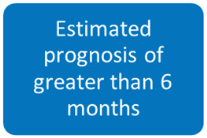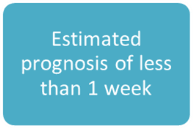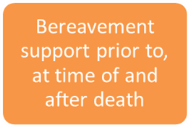DEFINITION
“PALLIATIVE CARE is the care for people of all ages with a life-limiting or life-threatening condition which aims to:
- Optimise an individual’s quality of life until death by addressing the person’s physical, psychosocial, spiritual and cultural needs.
- Support the individual’s family, whānau, and other caregivers where needed, through the illness and after death1.”
Palliative care is provided according to an individual’s need, and may be suitable whether death is days, weeks, months or occasionally even years away. It may be suitable sometimes when treatments are being given aimed at improving quantity of life.
PURPOSE
Identifying palliative care need is fundamental to providing quality palliative care for individuals and their family and whānau. Identifying palliative care need in the older person with co-morbidities can be challenging.
The use of tools such as the SPICT (Supportive Palliative Care Indicator Tool) assists in recognizing the level of palliative care need a person has and allows clinicians to plan care for/with the resident, their family and whānau.
CRITERIA FOR US
On admission to an ARC and/or when a person’s condition changes, assess their palliative care need using the SPICT tool.
The surprise question “Would I be surprised if this resident were to die within the next 12 months/6 months/weeks” is a useful indicator of need.
PALLIATIVE CARE NEED
Identify those who would benefit from a palliative care approach;
Use the SPICT tool to guide you clinical decision making.

EARLY PALLIATIVE CARE
Assessment:
- Resident may be recognized as having a life limiting illness however may have stable symptoms and have months or years to live
- Would you be surprised if this person were to live longer than the next 6-12 months?
Care management:
- At time of admission assess palliative care need, check if an Advance Care Plan (ACP) has been completed.
- As part of the admissions process (21 day care plan) discuss the wishes for future care – having an ACP discussion and documenting the person’s wishes is a critical part of care planning.
- If an ACP is completed ensure this is kept in a place that is accessible and goals are reflected in the nursing care plan. Ensure the General Practice Team are aware of this.
- Review a person’s wishes for care and /or their ACP six monthly
- Have you got policies and guidance documents to support staff in delivering quality palliative care for the resident and their family and whānau?

INCREASING PALLIATIVE CARE NEED
Assessment:
- Would you be surprised if this person were to die within the next 6 months?
- Is the person’s InterRAI CHESS score a 4 or 5?
- Is the person experiencing increasing symptoms from their underlying condition/s? Use the SPICT tool to inform this.
Care management:
- Is the General Practice Team aware of person’s changing condition and are they in agreement with identified need?
- Include the resident with increasing palliative care need in the next palliative care needs review held by the NP/CNS from Arohanui Hospice.
- Has the person and their family, whānau or caregivers been spoken with about the palliative approach to care?
- A ‘Family Meeting’ is offered to ensure resident, family and whānau are aware of changing condition and palliative approach to care. This could be done as a specific “Palliative Approach Family Meeting” (Access this documentation through Arohanui Hospice website) or as part of the three monthly review or annual MDT meeting (if timing is suitable). These can be fully nurse led with the GP contributing at another time.
- Review any previously written advance directive or advance care plan and ensure up to date documentation is kept of persons and families wishes and goals of care.
- Review monthly.

LAST DAYS OF LIFE
Assessment:
- Recognising dying can be challenging in older people with comorbidities.
- Assessment by the multidisciplinary team including the resident (if appropriate) and the family is necessary.
- Ensure all underlying causes of deterioration are resolved appropriately.
Care management:
- Review wishes and goals of person and their family and whānau including place of care.
- Ensure family are well informed of direction of care, this will include written information.
- Use a Last Days of Life Care Plan to assist and guide care.
- Ensure anticipatory prescribing is completed.
- Ensure adequate resources are in place, e.g. syringe driver, pressure relieving mattress.
- Ensure family are well communicated with.
- Ensure staff are supported.

BEREAVEMENT SUPPORT
Palliative Care does not end with the death of a person. Bereavement support is a key component of quality palliative care.
Bereavement support begins with preparation for dying, and this should be implemented early. The discussions with whānau, family, and friends should be documented and reviewed regularly by the multidisciplinary team. Bereavement support needs to be personalized to the person’s age, cultural and belief diversity, disability or gender factors.
The Palliative Care Bereavement Support Guidelines Resource Toolkit2 has been developed to assist health professionals and organizations provide bereavement support to their residents and families and whānau. This is available through this link Arohanui Hospice Bereavement Support Toolkit
- Ministry of Health. 2015. New Zealand Palliative Care Glossary. Wellington: Ministry of Health.
- MidCentral District Health Board. (2016). Bereavement Support Guidelines.

